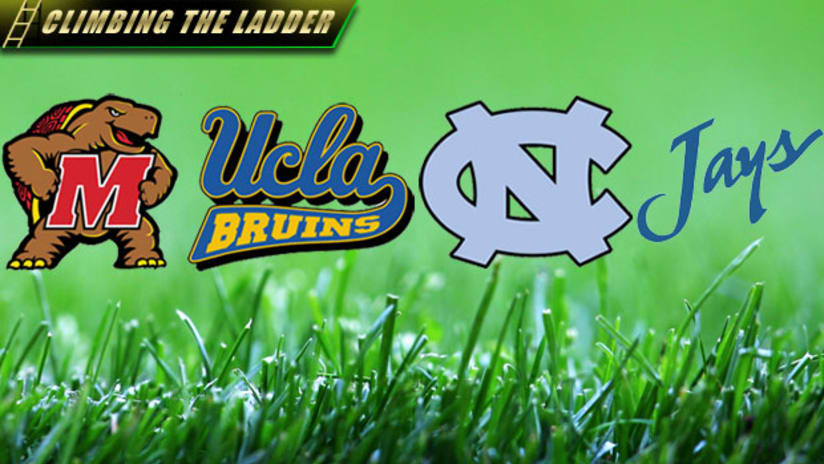The MLS season may be over, but soccer in the United States never takes an offseason.
This coming weekend, the last four teams will contest the NCAA College Cup to determine the top team in men’s Division I soccer. North Carolina takes on UCLA in one semifinal, while UNC Charlotte and Creighton tangle in the second.
North Carolina and Creighton may be the two highest seeds in the tournament, but when it comes to future MLS talent, UCLA is unparalleled. A total of 57 Bruins have played in an MLS regular-season game, which far outpaces the 42 from second-place Virginia.
| Highest MLS Average: Games Played | |||||
| Rank | School | Players | Avg. GP | Median GP | Avg. Goals |
| 1 | FIU | 11 | 118.1 | 28 | 10.0 |
| 2 | UCLA | 57 | 101.5 | 75 | 8.9 |
| 3 | Indiana | 29 | 98.7 | 54 | 7.7 |
| 4 | Creighton | 13 | 92.6 | 40 | 7.0 |
| 5 | Stanford | 12 | 87.2 | 59 | 4.5 |
| 6 | UNC | 29 | 83.7 | 40 | 3.3 |
| 7 | Duke | 16 | 80.9 | 58 | 10.2 |
| 8 | Saint Louis | 18 | 77.3 | 31 | 9.5 |
| 9 | Virginia | 42 | 76.4 | 53 | 4.8 |
| 10 | Santa Clara | 17 | 75.9 | 31 | 6.4 |
Next is Maryland with 37, while North Carolina is tied for fourth at 29 with Indiana. Creighton has also fared well, sending 13 Jays to MLS to rank in the top 20 schools.
Compared to the other three more traditional powers, Charlotte is way behind, at four players. However, that does include one notable, in goalkeeper Jon Busch. The former 49er and current San Jose Earthquakes netminder was in goal the one and only previous time they made the College Cup, in 1996.
It appears this team isn’t expected to increase that number — the MLSsoccer.com Big Board of the top prospects includes no Charlotte players. In contrast, it has multiple members of each of the other final three.
The interesting thing about the talent that has came out of UCLA is not just the quantity, but the quality as well. Carlos Bocanegra, Jimmy Conrad, Brad Friedel, Cobi Jones, Ante Razov; the list just goes on and on.
How much has UCLA dominated the scene? Their players have played more MLS games combined than any other entire conference’s players, except for the ACC. In addition, there are only 75 players to have reached 200 games played in MLS; 11 played for UCLA, while no one else has more than five.
With so many men turning professional, it might be natural to think that the numbers are padded with lesser performers, but that’s not the case at all. The average MLS player has played 51 games in his career. The average UCLA Bruin? Nearly twice that, at more than 100 games.
Of the 25 schools who’ve sent at least 10 players to MLS, they rank second for the average number of games played by those players. What’s more, they also rank a clear first when looking at the median, which is probably a better indicator of the average talent level.
| Most MLS Players, by Conference | |||||
| Rank | School | Players | Avg. GP | Median GP | Avg. Goals |
| 1 | ACC | 186 | 68.4 | 40 | 5.5 |
| 2 | Pac-12 | 124 | 78.2 | 53 | 6.3 |
| 3 | Big East | 91 | 49.5 | 18 | 5.2 |
| 4 | Big Ten | 51 | 63.9 | 23 | 4.7 |
| 5 | West Coast | 51 | 68.0 | 35 | 7.0 |
| 6 | C-USA | 50 | 66.7 | 27 | 6.6 |
| T-7 | Atlantic 10 | 36 | 75.6 | 29 | 8.1 |
| T-7 | Big West | 36 | 37.6 | 14 | 2.2 |
| 9 | MVC | 32 | 74.0 | 31 | 4.6 |
| 10 | Ivy | 27 | 40.2 | 13 | 2.6 |
Florida International has the best average thanks to four longtime MLS stars: Bobby Boswell, Robin Fraser, Tyrone Marshall and Steve Ralston. The median isn’t quite so good, indicating how top-heavy FIU is. The two lowest-ranking double-digit schools are Akron (30.5) and California (25.8), though that’s due to the fact that most of their draft picks have come in the last few years.
Not to be overlooked, Creighton and North Carolina both rank pretty high in quality as well. In fourth place, Creighton’s most experienced pros are Brian Kamler, Brian Mullan, Richard Mulrooney and Ross Paule.
North Carolina is in sixth, and as the lower average number of goals might indicate, they’ve mainly sent defensive-minded prospects to the big leagues like Gregg Berhalter, Logan Pause, Eddie Pope, Eddie Robinson and Kerry Zavagnin.
As mentioned, the ACC is the clear winner as far as conferences are concerned. The Pac-12 and Big East complete the “Big 3,” although the latter hasn’t quite sent the quality that some of the others in the top 10 have. All statistics are based on the current 2011 make-ups of the conferences.
Of course, men’s college soccer consists of more than just one division. This year’s champions include Fort Lewis (Colorado) in Division II, Ohio Wesleyan in Division III and Lindsey Wilson (Kentucky) in the NAIA. Combined, those three divisions have sent more than 100 players to MLS, including everyone’s favorite example, Chico State’s Chris Wondolowski.
| MLS Player Breakdown, by Division | |||||
| Players | PCT | Avg. GP | |||
| D1 | 827 | 51.1% | 63.2 | ||
| D2 | 60 | 3.7% | 101.5 | ||
| D3 | 20 | 1.2% | 23.0 | ||
| NAIA | 21 | 1.3% | 29.8 | ||
| JC | 17 | 1.1% | 44.9 | ||
| None/Other | 672 | 41.6% | 38.4 | ||
There are also junior colleges, which have provided a surprising amount talent like Edson Buddle and Stern John.
Sixty players from Division II makes it a good place to find lesser-known prospects. One school deserving a special mention is Southern Connecticut State, which has had 11 MLS players, including Mike Petke.
That’s easily the most outside D-I. These statistics use the current make-up of each division, and for players who attended multiple colleges, only the last one is counted.
Besides those who didn’t attend a college, the none/other category includes a small number of foreign colleges (mostly Canadian) and colleges which have dropped their soccer programs.











